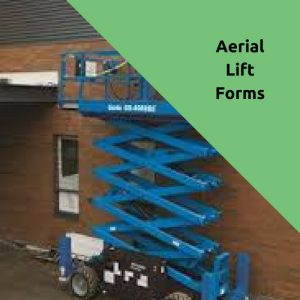Aerial Lifts
 Aerial lifts, often called scissor lifts, are powered and mobile platforms that are used for elevating workers to various heights, which exposes workers to fall hazards.
Aerial lifts, often called scissor lifts, are powered and mobile platforms that are used for elevating workers to various heights, which exposes workers to fall hazards.
An aerial lift presents an interesting situation in the workplace. Many employers treat these as powered equipment, when by regulation, they are actually considered scaffolding and have different requirements. This isn’t to say that aerial equipment is to be used without training, but the training and records are different.
If your workplace uses a scissor lift, it is important to know how to operate the equipment safely and in compliance to all relevant regulations.
To learn more about OSHA regulations pertaining to scissor lifts, there is this handy fact sheet, put out by OSHA.
For convenience I am including it in reader view below.
OSHA3842If you need other components of a powered equipment program, check out all I offer here
Why Aerial Lift Safety Training Matters:
- OSHA estimates that there are about 68,000 fall-related injuries in the workplace each year.
- OSHA requires equipment with aerial lifts to be designed and constructed according to certain standards. The primary goal is to protect the worker in the lift by providing fail-safe mechanisms that will prevent a free-fall descent of the work platform.
- One of the primary hazards of working in aerial lifts is falling out of the lift.
- If you work in aerial lifts or near them on the ground, you need to understand the hazards, the basic regulatory requirements, and the safety work practices that must be followed to prevent accidents and injuries.
NIOSH offers a free simultor for aerial lifts, which shouldn’t be used in place of full and proper training of operators, but can be used to augment the training offered in the workplace.
Below is the NIOSH Fact Sheet on Aerial Lifts and their simulator:
aerial lift simulator NIOSHYou can find the NIOSH Aerial Lift Simulator here
View and download all components of an Aerial lift safety program below

Key Points:
- Aerial lifts are useful pieces of equipment but can also be hazardous.
- Lifts must be operated properly to prevent accidents and injuries.
- Only trained and authorized employees are allowed to use aerial lifts.
- Inspect equipment and the work area before each use.
- Understand and follow safe work practices, including wearing fall protection equipment.
- Be especially careful when working around power lines.
No quality training program is complete without an evaluation, so ensure that employees are observed in their operation of the aerial lift by a competent person.

Even with well trained employees operating aerial lifts, safety in the workplace is only as good as the equipment being used. The aerial lift, like powered equipment, should be inspected daily, before use, to ensure it is safe to operate.
Like powered equipment, this inspection is not required to be written, but written forms allow for proper auditing of program compliance, while also providing a paper trail to address issues.

